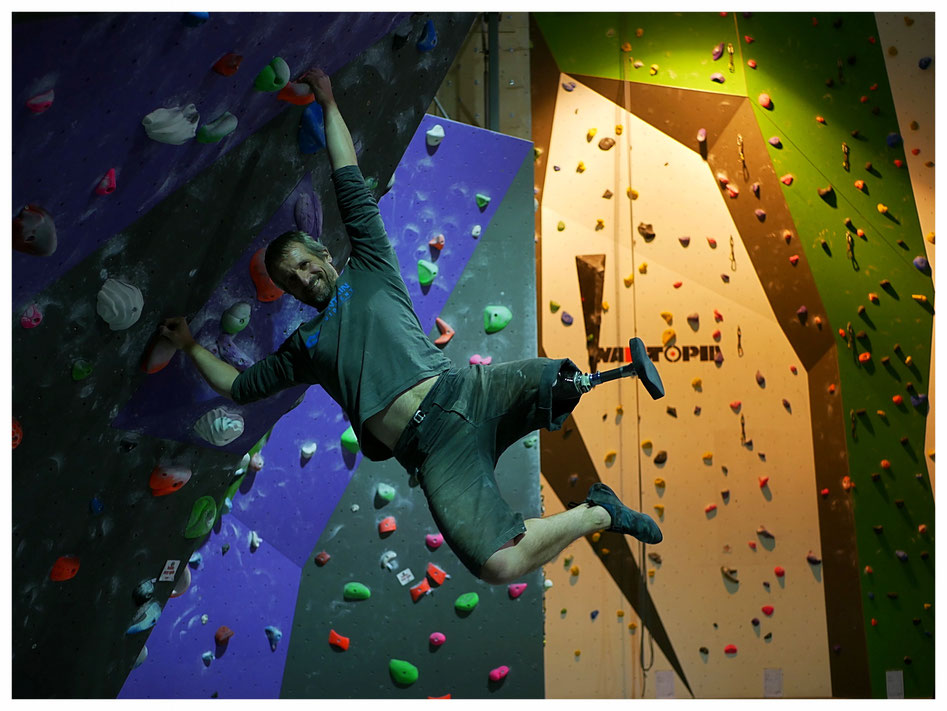The ADK Climbing Foot
Climbing is a great sport. And there is no reason why people with a limb difference shouldn‘t give it a try. I have been climbing for a couple of years now and I tried a variety of set-ups for my prosthesis; i.e. completely without any artificial limb (no socket, no knee, no foot, no nothing) and with the C-Leg (but with my normal day-to-day foot) before settling on the ADK climbing foot. The ADK foot is a rather unspectacular piece of gear but it works surprisingly well for me. It‘s a simple construction that I mount directly underneath my socket. And while the foot has a few issues I would like to change, I am generally satisfied with it.
Here Are The Pros And Cons
What I like about the foot
- Small and light - While this is not much of an issue indoors or when your outdoor climb is close to the car par. But when you are already hauling a substantial amount of climbing gear over several kilometres, using small and often slippery paths up and down the hills, you learn to appreciate the fact that the ADK foot easily fits into your pack.
- Rather inexpensive - When I bought the foot, many of the alternatives were much more expensive. So especially when you are not yet sure if a certain foot works for you - or if you are not yet sure if you want to climb regularly - this is a big issue. I heard that things have changed, so make sure you check other options; e.g. the Evolv Adaptive Foot etc.
- Precise foot placement possible - I mount the foot directly underneath my socket. While this set-up does not give me the reach I would like to have for bridging, I found this to be the best compromise between reach, exact foot placement, being able to keep my centre of gravity close to the wall when moving the leg and using the foot to actually smear.
- Smearing - As mentioned above, once you figured out the right set-up/length for you, this foot actually smears well. Something I find of incredible value especially as footholds on my amputation side are often out of reach. While the original rubber sole was okay-ish, smearing worked even better once I had it re-soled.
- Easy to repair - The ADK foot is a simple piece of gear and most of the wear and tear can be repaired quite easily.
What could be improved
- Rubber sole - In my eyes the rubber sole has been the weakest part of the ADK climbing foot. Especially the fact that the two main parts are joint at the very spot where the foot is normally placed on holds this is in my eyes a design flaw.
- Sturdiness - I heard other climbers complaining that the food is generally too weak and of too low a quality for serious climbing on a regular base. For me this has not been an issue (except for the above-mentioned issue of the rubber sole). Having said that, I climb mostly indoors and feel immensely lucky if I get more than half a day of climbing per week.
Conclusion
I like the ADK climbing foot and so do my finger joints. Since I use the food, I have much less problems regarding finger injuries/wear and tear, so to speak. The fact that I can now shift my weight onto the artificial foot when bringing the other leg up is a big plus. Before all my weight rested on my fingers during every move with the remaining leg. Especially on small and crimpy holds this climbing style took its toll on my finger joints.
So if you are looking for a simple climbing foot, I think the ADK is worth checking out. For about US$ 225.00 it offers an affordable solution to amputee climbers. But with the new Evolv foot on the market, which comes in at about the same price, I think the ADK faces some tough competition.

